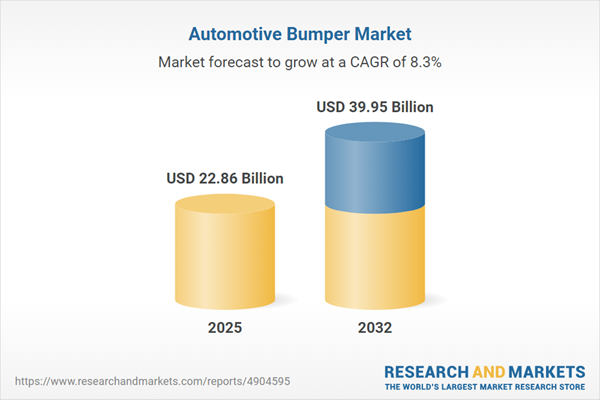Speak directly to the analyst to clarify any post sales queries you may have.
Senior decision-makers in the automotive industry are navigating a complex and evolving automotive bumper market shaped by regulatory changes, technological advances, and growing sustainability demands. Strategic market intelligence focused on the automotive bumper sector is increasingly vital for executives looking to anticipate disruption, maintain compliance, and achieve operational excellence.
Market Snapshot: Automotive Bumper Market Overview
The automotive bumper market is experiencing steady advancement, propelled by tightening global safety and environmental regulations alongside the growing shift toward electric vehicles. Key players are adapting to a landscape marked by ongoing innovation in materials and processes. Eco-friendly technologies continue to present both new operational opportunities and added complexity, requiring manufacturers and suppliers to operate with increased agility. Emphasis on digital collaboration and advanced product development allows companies to respond proactively to shifting consumer preferences and regulatory requirements. This dynamic, responsive approach supports market competitiveness, alignment with emerging industry standards, and continued growth.
Scope & Segmentation: Key Coverage Across the Automotive Bumper Market
- Material Types: Advanced composites, high-strength metals, and innovative polymers—including ABS and polypropylene—help manufacturers achieve compliance with regulatory and environmental benchmarks worldwide.
- Distribution Channels: Emphasis on digital procurement strengthens supplier relationship management and increases transparency in both global and regional supply chains, facilitating improved efficiency and oversight.
- Installation Models: Insights into OEM and aftermarket installation approaches reveal essential differences in lifecycle management and resource optimization, supporting enhanced strategic allocation for desired outcomes.
- Application Zones: Integration of front and rear bumper systems highlights the balance between regulatory-driven safety advances and design innovation to meet the needs of different vehicle categories.
- Vehicle Types: Bumper solutions are tailored to address the specific requirements of passenger cars as well as light and heavy commercial vehicles, reflecting the diverse legislative and operational needs across major markets.
- Geographic Regions: Regional factors—including varying consumer preferences and regulatory frameworks in the Americas, Europe, Asia-Pacific, Middle East, and Africa—shape production and procurement strategies for compliance and localized sourcing.
- Key Technologies: Critical adoption areas include energy-absorbing structures, embedded smart sensors, additive manufacturing, and recycled materials to drive supply resilience and regulatory adherence.
- Company Coverage: Comparative analysis of leading companies offers strategy insights into competitor investments, innovation pipelines, and market positioning in bumper development.
Key Takeaways for Strategic Decision-Making
- Advanced composite materials strengthen bumper durability and align with sustainability objectives across both OEM and aftermarket sectors.
- Adoption of digital engineering and virtual prototyping enhances flexibility, making rapid product reconfiguration more achievable while supporting cost containment targets.
- Growing electric vehicle integration increases the need for modular bumper designs and advanced safety features, shaping industry-wide innovation priorities.
- Deployment of smart sensor technologies is transforming procurement and product development workflows, enabling compliance with sophisticated regulatory demands and supporting quicker market adaptation.
- Use of recycled content, combined with proactive supply chain risk management, provides resilience as global compliance and sourcing requirements evolve.
- Collaborative partnerships with technology providers enable manufacturers to address changing industry standards, supporting higher adaptability and operational continuity.
Tariff Impact: Navigating Policy Shifts
Recent U.S. tariffs on steel and aluminum have led bumper manufacturers to reevaluate sourcing and supply chain models. Companies are focusing on sourcing metals locally, seeking alternatives to primary materials, and updating procurement strategies to mitigate increased costs. These adjustments are particularly impactful in the aftermarket segment, complicating price management and posing additional challenges for supply chain stability amid ongoing trade policy fluctuations.
Methodology & Data Sources
This report draws on direct interviews with senior automotive executives, thorough review of leading industry publications, and continuous monitoring of global regulatory developments. The methodological approach ensures reliable, executive-focused insights to inform high-level strategic planning.
Why This Report Matters for Executive Decision-Making
- Provides focused analysis on regulatory, technological, and supply chain shifts, supporting executive decisions that reduce risk and improve operational efficiency.
- Helps senior leaders refine strategies across the value chain to proactively address evolving compliance and policy requirements.
- Delivers essential market intelligence and strategic benchmarks to guide innovation, sourcing, and investment planning in the automotive bumper sector.
Conclusion
This report enables senior automotive leaders to anticipate market changes, develop robust response strategies, and ensure ongoing organizational strength within the dynamic automotive bumper industry.
Additional Product Information:
- Purchase of this report includes 1 year online access with quarterly updates.
- This report can be updated on request. Please contact our Customer Experience team using the Ask a Question widget on our website.
Table of Contents
3. Executive Summary
4. Market Overview
7. Cumulative Impact of Artificial Intelligence 2025
Companies Mentioned
The companies profiled in this Automotive Bumper market report include:- Magna International Inc.
- Plastic Omnium S.A.
- Forvia SE
- Toyoda Gosei Co., Ltd.
- Motherson Sumi Systems Limited
- Yanfeng Automotive Trim Systems Co., Ltd.
- Hyundai Mobis Co., Ltd.
- SMP Deutschland GmbH
- Plasman
- Flex-N-Gate Corporation
Table Information
| Report Attribute | Details |
|---|---|
| No. of Pages | 194 |
| Published | October 2025 |
| Forecast Period | 2025 - 2032 |
| Estimated Market Value ( USD | $ 22.86 Billion |
| Forecasted Market Value ( USD | $ 39.95 Billion |
| Compound Annual Growth Rate | 8.3% |
| Regions Covered | Global |
| No. of Companies Mentioned | 11 |









